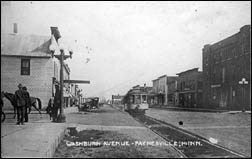
Historical
Society
2000 Articles
First 50 Years
8.9.00
Mail Carriers
8.2.00
Indians
7.26.00
Museum Cars
7.19.00
Paynesville Firsts
7.12.00
Dolls
7.5.00
Schools
6.28.00
Bison
6.14.00

|
Notes from the Paynesville Historical Society. . .
The first 50 years of Paynesville
John McCormack and M.L. Bullard made a second attempt and located a claim and laid out a town site where we are now. When the surveys were made, it was found these claims and town site were located on the school section and must be abandoned.
In the fall of 1856, a town site commonly known as the Paynesville Town Site Company, conceived the idea that the land previously owned by Edwin E. Payne, was the proper place for the location of a city. E.E. Payne was one of the first settlers here. In the fall of 1857, the land was surveyed and a town site was plotted out. The name of the town, Paynesville, was given in the honor of E.E. Payne.
The area of territory in the town of Paynesville was first 240 acres, but some years later, the north half was vacated, leaving only that part of the territory south of the Crow River.
The town of Paynesville in 1857 was the area of 120 acres and in 50 years, 1907, it grew to 420 acres so you can just about imagine the expansion of our beautiful city.
In 1858, on July 4, a heavy frost killed the rye crop and the farmers were suffering. That didn't stop them from celebrating their first Fourth of July. Two wagons brought participants to the lake for the celebration. This really united the town into one.
Ironically, two years later, the farmers came back and grew their first crop of grain, which amounted to too much. Everyone rejoiced.
From the span of 1856 until 1907, there was a terrible blizzard. It was actually the worst blizzard in this time span. It happened on Jan. 2, 1873. Many people were devastated. In relation to the blizzard, in 1880, there was such freezing temperatures that the men froze to death walking from their house to the barn, literally.
In May of 1881, a very proud honor was given to Paynesville. It received an honor of being the only no licensed town in Stearns County.
Here is an excerpt from a paper that was read by Frank Tolman at the celebration held at Paynesville for the 50th anniversary of our town: "There is a far cry between the crowd of 25 that might have attended the celebration of July 4, 1857, and the crowd that is here today. Those 50 years tell a tale of real and human interest, a tale of short experience in Indian warfare, a tale of growth and change, which was absorbing in many ways, but too long to give other than a brief outline this morning."
Actually, the town in 1857 was not an organized township or a village. The village of Paynesville was not fully organized until 1887. Then the railroads came, and the village of "New Paynesville" was organized in 1880. Then there was "Jim Town," "Old Town," and "North Town."
The people of these towns didn't get along because of jealousy of the placing of the railroads and where the town was going to eventually settle. In the fall of 1904, "the angel of peace descended" and Paynesville was attached to the New Paynesville, which had a population of 1,200 people. In 1905, the name New Paynesville was officially changed to Paynesville.
In the final year of the 50 years, Paynesville had eight church buildings with four resident pastors, a presidential third class post office with a postmaster, one assistant, five rural routes, and six daily mails. They also had a school which included all grades through high school, and also had a superintendent, a principal, and an assistant to the teachers.
An interesting fact in connection with Paynesville is that for some time it was not a part of any county. Referring to the surveys taken on the boundaries of the counties, Paynesville did not lie within Stearns or any other county. A special act of the Legislature was necessary to attach it to Stearns County.
|
 Our beautiful town of Paynesville was founded in the year of 1856. A party of settlers from St. Cloud, who were led by William Reed, located a town site and left.
Our beautiful town of Paynesville was founded in the year of 1856. A party of settlers from St. Cloud, who were led by William Reed, located a town site and left.